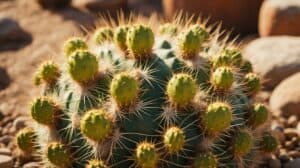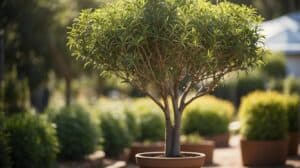Cephalocereus senilis, commonly known as the Old Man Cactus, is a slow-growing, columnar cactus with a shaggy coat of white hairs that resemble an old man’s beard.
This cactus is native to Mexico and is a popular choice among cactus enthusiasts due to its unique appearance.
However, caring for the Old Man Cactus can be a bit challenging, as it requires specific growing conditions to thrive.

To keep the Old Man Cactus healthy and happy, it is essential to provide it with the right amount of light, water, and nutrients.
This cactus prefers bright, indirect light and can tolerate some direct sunlight, but too much can damage its delicate hairs.
It is also important to water the Old Man Cactus sparingly, as it is susceptible to root rot.
Additionally, providing it with well-draining soil and regular fertilization can help promote healthy growth.
In this article, we will explore the best practices for caring for the Old Man Cactus, including tips on lighting, watering, soil, and fertilization.
Whether you are a seasoned cactus collector or a beginner, this guide will provide you with the knowledge you need to keep your Cephalocereus senilis thriving for years to come.
Understanding Cephalocereus Senilis
Species Overview
Cephalocereus Senilis, also known as the Old Man Cactus, is a species of cactus native to Mexico.
It is a slow-growing cactus that can reach up to 8 feet in height and 3 feet in width.
The cactus has a unique appearance, with a thick, shaggy layer of white hair covering its stem.
The hair serves as a protective layer against the harsh sun and helps the cactus retain moisture.
The Old Man Cactus produces small, white flowers that bloom in the summer months.
The flowers are followed by small, red fruits that are edible but not commonly consumed.
Growth Characteristics
Cephalocereus Senilis is a hardy cactus that can tolerate a range of temperatures and soil conditions.
It prefers well-draining soil and full sun exposure, but can also grow in partial shade.
The cactus is drought-tolerant and can go for long periods without water.
The Old Man Cactus is a slow-growing plant and can take several years to reach its full height.
It is important to note that the cactus may not produce its characteristic white hair until it reaches maturity, which can take up to 10 years.
When caring for Cephalocereus Senilis, it is important to avoid overwatering.
The cactus should be watered sparingly, allowing the soil to dry out completely between waterings.
Fertilizer should be applied sparingly, as the cactus is adapted to nutrient-poor soil.
In conclusion, Cephalocereus Senilis is a unique and hardy cactus that can make a great addition to any collection.
With proper care and attention, the Old Man Cactus can thrive for many years.
Essential Care Guidelines

Lighting Requirements
The Cephalocereus Senilis requires bright, indirect sunlight to thrive.
It is best to place the plant near a south or west-facing window, where it can receive at least six hours of sunlight per day.
However, direct sunlight can scorch the plant, so it is important to provide some shade during the hottest hours of the day.
Watering Techniques
The Old Man Cactus is a drought-tolerant plant that needs infrequent watering.
It is best to water the plant deeply, allowing the soil to dry out completely between waterings.
Overwatering can cause root rot, which can be fatal to the plant.
It is also important to avoid getting water on the plant’s hairy exterior, as this can lead to fungal growth.
Soil and Potting Mix
The Cephalocereus Senilis prefers well-draining soil that is rich in organic matter.
A cactus or succulent potting mix is ideal, as it is formulated to provide the proper drainage and nutrients for these types of plants.
It is also important to use a pot with drainage holes to prevent water from accumulating in the soil.
Temperature and Humidity Control
The Old Man Cactus thrives in warm temperatures, between 60-85°F (15-29°C).
It can tolerate some fluctuations in temperature, but it is important to avoid exposing the plant to temperatures below 50°F (10°C).
Additionally, the plant prefers low humidity levels, so it is best to avoid placing it in a humid environment.
By following these essential care guidelines, you can ensure that your Cephalocereus Senilis thrives and remains healthy for years to come.
Propagation and Repotting

Propagation Methods
Cephalocereus Senilis can be propagated through seeds or stem cuttings. Seeds can be sown in a well-draining soil mix and kept moist until germination.
Stem cuttings should be taken in the spring and allowed to callus over for a few days before being planted in a well-draining soil mix.
The cuttings should be kept in a warm, bright location and watered sparingly until new growth appears.
Repotting Steps
Repotting should be done every 2-3 years in the spring. When repotting, it is important to use a well-draining soil mix and a pot with drainage holes.
To repot, gently remove the cactus from its current pot and carefully remove any excess soil from the roots.
Place the cactus in the new pot and add fresh soil around the roots, making sure to leave enough space for watering.
Water sparingly for the first few weeks after repotting to allow the roots to settle in.
It is important to note that Cephalocereus Senilis has a shallow root system, so it is recommended to use a wide, shallow pot rather than a deep one.
Additionally, this cactus is sensitive to overwatering, so it is important to allow the soil to dry out completely between waterings.
Overall, propagating and repotting Cephalocereus Senilis is a simple process that can help ensure the health and longevity of this unique and interesting cactus.
Pest Management and Troubleshooting

Common Pests
Cephalocereus Senilis is susceptible to a few common pests, including mealybugs and spider mites.
These pests can be identified by their small size and the web-like substance they leave behind.
To prevent infestations, it is important to inspect the plant regularly and keep it clean.
If an infestation is detected, it can be treated with an insecticidal soap or neem oil.
Disease Prevention
Cephalocereus Senilis is generally a hardy plant, but it can be susceptible to root rot if overwatered or if the soil does not drain well.
To prevent root rot, it is important to use a well-draining soil mix and to avoid overwatering.
Additionally, it is important to inspect the plant regularly for any signs of disease or damage.
If any issues are detected, they should be addressed promptly to prevent further damage.
Troubleshooting Tips
If your Cephalocereus Senilis is not thriving, there are a few troubleshooting tips you can try.
First, check the soil moisture levels and adjust watering as needed. Additionally, make sure the plant is getting the appropriate amount of sunlight.
If the plant is not getting enough light, it may become leggy or develop a yellowish color.
Finally, inspect the plant for any signs of pests or disease and address any issues promptly.
With proper care and attention, your Cephalocereus Senilis should thrive and continue to be a beautiful addition to your home or garden.
Frequently Asked Questions

What are the ideal lighting conditions for an Old Man Cactus?
The Old Man Cactus thrives in bright, indirect light.
It is best to place the cactus near a south-facing window, but be sure to protect it from direct sunlight, as it can scorch the plant.
If the cactus is not receiving enough light, it may start to stretch out, losing its characteristic shape.
How do you propagate an Old Man Cactus?
The Old Man Cactus can be propagated by taking stem cuttings. Let the cuttings dry for a few days before planting them in well-draining soil.
Keep the soil moist and place the cuttings in a bright, indirect light until they start to root.
What should I do if my Old Man Cactus starts to droop?
If your Old Man Cactus starts to droop, it may be a sign of overwatering. Allow the soil to dry out before watering it again.
If the cactus is still drooping, it may be a sign of root rot, which can be caused by overwatering or poor drainage.
In this case, it may be necessary to repot the cactus in fresh, well-draining soil.
How frequently should I water my Old Man Cactus?
The Old Man Cactus is a drought-tolerant plant and should be watered sparingly.
Water the cactus only when the soil is completely dry, which may be once every two to three weeks.
Can the Old Man Cactus tolerate cold temperatures?
The Old Man Cactus is native to hot, dry regions and is not cold-tolerant.
It should be kept in a warm, dry location and protected from temperatures below 50°F.
What are the common pests that affect the Old Man Cactus and how can I deal with them?
The Old Man Cactus is susceptible to mealybugs, spider mites, and scale insects.
These pests can be removed by wiping the cactus with a cotton swab dipped in rubbing alcohol.
In severe cases, it may be necessary to use an insecticidal soap or oil to control the infestation.














